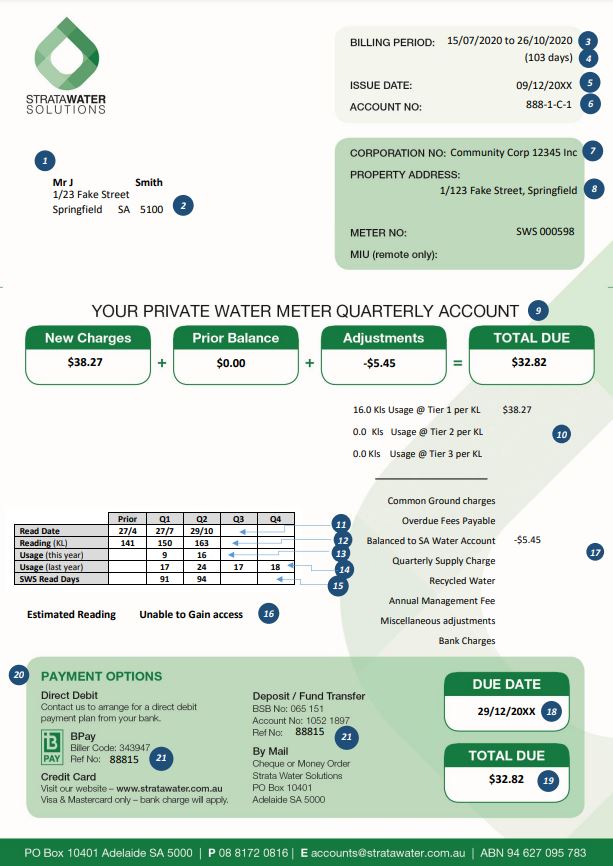1. Your Name
2. Postal Address
3. SA Water Billing Dates
4. No. of Days in SA Water Billing Cycle
5. Date of Issue
6. Your Unique Account Number
7. Strata/Community Corporation number
8. Property Address
9. The type of account e.g cold water, gas, electricity, etc.
10. Water used by tier level
11. Date Strata Water read the private meter
12. Reading on the private meter
13. Water Usage by KL in the quarter
14. Water Usage by KL in the same quarter last year
15. Number of Strata Water reading days
16. Meter Reading Issues
17. Other Charges as specified where applicable
18. Due Date
19. Total Due
20. Payment Options
21. Payment Reference Number
2. Postal Address
3. SA Water Billing Dates
4. No. of Days in SA Water Billing Cycle
5. Date of Issue
6. Your Unique Account Number
7. Strata/Community Corporation number
8. Property Address
9. The type of account e.g cold water, gas, electricity, etc.
10. Water used by tier level
11. Date Strata Water read the private meter
12. Reading on the private meter
13. Water Usage by KL in the quarter
14. Water Usage by KL in the same quarter last year
15. Number of Strata Water reading days
16. Meter Reading Issues
17. Other Charges as specified where applicable
18. Due Date
19. Total Due
20. Payment Options
21. Payment Reference Number
How your bill is generated
1. Your sub meter is read according to the schedule provided by SA Water. There are variations in the reading dates
between Strata Water Solutions and the SA Water Meter Reading Contractors. We read from the scheduled dates and as close as possible to the standard 91 day quarter.
2. The charges are applied to usage at the rates (and under the same rules) as those defined for a utility account.
3. Variations in usage (as referred to in 1. above) are spread on a pro rata basis according to your actual usage.
1. Your sub meter is read according to the schedule provided by SA Water. There are variations in the reading dates
between Strata Water Solutions and the SA Water Meter Reading Contractors. We read from the scheduled dates and as close as possible to the standard 91 day quarter.
2. The charges are applied to usage at the rates (and under the same rules) as those defined for a utility account.
3. Variations in usage (as referred to in 1. above) are spread on a pro rata basis according to your actual usage.

